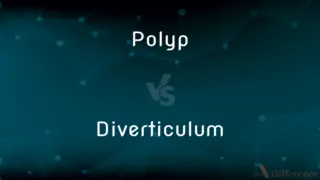Capuchin vs. Sai — What's the Difference?
By Maham Liaqat & Fiza Rafique — Updated on March 30, 2024
Capuchin monkeys are New World primates known for their intelligence, while saí monkeys, or tamarins, are recognized for their small size and distinctive features.

Difference Between Capuchin and Sai
Table of Contents
ADVERTISEMENT
Key Differences
Capuchin monkeys, belonging to the genus Cebus, are highly intelligent and adaptable primates found in Central and South America. They are renowned for their use of tools, complex social structures, and problem-solving abilities. Capuchins have a broad diet that includes fruits, insects, and small vertebrates. On the other hand, saí monkeys, often referred to as tamarins and belonging to the genus Saguinus, are much smaller primates with distinctive facial hair patterns and long, non-prehensile tails. Tamarins are known for their small size, quick movements, and being primarily frugivorous, although they also eat insects and other small animals.
Capuchin monkeys are larger and have a more varied diet compared to the smaller saí monkeys, which impacts their habitat use and social behaviors. While capuchins can manipulate objects and use tools to access food or solve problems, saí monkeys rely more on their agility and speed to forage and evade predators. The social structure of capuchins is more complex, with clear hierarchies and roles within the group, whereas tamarins tend to have smaller, more cooperative breeding groups.
The physical appearance between the two is also distinct; capuchins generally have a more uniform coloration, while saí monkeys boast more vibrant and varied color patterns, often with striking facial and body markings. This difference in appearance reflects their adaptation to different niches in their respective environments.
Conservation status varies between the two, with some capuchin species being less threatened due to their adaptability, while many tamarin species face greater threats from habitat loss and fragmentation. Efforts to conserve both types of primates are crucial for maintaining biodiversity and ecological balance in their habitats.
Comparison Chart
Genus
Cebus
Saguinus
ADVERTISEMENT
Size
Larger, with more robust bodies
Smaller, with delicate bodies
Diet
Omnivorous, eating fruits, insects, and small vertebrates
Primarily frugivorous, supplemented with insects and small animals
Social Structure
Complex hierarchies, larger groups
Smaller, cooperative breeding groups
Tool Use
Known for using tools to access food or solve problems
Primarily rely on agility and speed, with less emphasis on tool use
Physical Appearance
Generally uniform coloration, with some variation
Vibrant and varied color patterns, including striking facial markings
Conservation Status
Varies, with some species less threatened
Many species face threats from habitat loss and fragmentation
Compare with Definitions
Capuchin
A genus of New World primates known for their intelligence and adaptability.
The capuchin monkey used a stone to crack open a nut.
Sai
Tamarins live in small, cooperative groups, often participating in communal care of offspring.
In saí monkey groups, both males and females help in caring for the young.
Capuchin
Known for their use of tools, capuchins have been studied extensively in cognitive research.
Researchers have documented capuchin monkeys using sticks to retrieve insects from tight spaces.
Sai
Small New World primates with distinctive markings and long tails.
The emperor tamarin, a type of saí monkey, is known for its long, white mustache.
Capuchin
Conservation efforts for capuchins focus on habitat preservation and anti-poaching measures.
Conservation programs are in place to protect capuchin monkey habitats from deforestation.
Sai
Their diet mainly consists of fruit, but they also consume insects and small animals.
Saí monkeys are often seen leaping through the canopy in search of ripe fruit.
Capuchin
Capuchins have complex social structures and exhibit problem-solving skills.
In the wild, capuchin monkeys form tight-knit groups that work together to find food.
Sai
Adapted to life in the treetops, they use their agility to evade predators.
The quick movements of saí monkeys make them difficult targets for predators.
Capuchin
They are versatile in their habitat and diet, which contributes to their survival.
Capuchin monkeys are adept at navigating both forest canopies and the forest floor in search of food.
Sai
Conservation of saí monkeys involves protecting their forest habitats from degradation.
Efforts to conserve saí monkey populations include establishing protected areas and wildlife corridors.
Capuchin
Capuchin A monk belonging to the Order of Friars Minor Capuchin, an independent order of Franciscans founded in Italy in 1525-1528 and dedicated to preaching and missionary work.
Sai
A handheld weapon with three prongs, used in some Oriental martial arts.
Capuchin
A hooded cloak worn by women.
Sai
A sajou; a capuchin (monkey).
Capuchin
Any of several monkeys of the genus Cebus of Central and South America, having a prehensile tail and often a black or brown cap of hair on top of the head. Also called sapajou.
Sai
(vulgar) shit
Capuchin
A monk in the Order of Friars Minor Capuchin; generally a Franciscan.
Sai
See Capuchin, 3 (a).
Capuchin
A garment consisting of a cloak and hood, made in imitation of the dress of Capuchin monks.
Capuchin
A capuchin monkey.
Capuchin
A hooded pigeon.
Capuchin
A Franciscan monk of the austere branch established in 1526 by Matteo di Baschi, distinguished by wearing the long pointed cowl or capoch of St. Francis.
A bare-footed and long-bearded capuchin.
Capuchin
A garment for women, consisting of a cloak and hood, resembling, or supposed to resemble, that of capuchin monks.
Capuchin
A long-tailed South American monkey (Cabus capucinus), having the forehead naked and wrinkled, with the hair on the crown reflexed and resembling a monk's cowl, the rest being of a grayish white; - called also capucine monkey, weeper, sajou, sapajou, and sai.
Capuchin
A hooded cloak for women
Capuchin
Monkey of Central America and South America having a cowl of thick hair on the head
Common Curiosities
How do the social structures of capuchins and saí monkeys differ?
Capuchins have larger, more hierarchical groups, while saí monkeys form smaller, more egalitarian groups focused on cooperative breeding.
Why are saí monkeys considered important for their ecosystems?
As primary frugivores, they play a crucial role in seed dispersal, contributing to the health and regeneration of their forest habitats.
What makes capuchin monkeys particularly interesting to researchers?
Their high intelligence, social complexity, and tool-use abilities make them subjects of interest in studies on primate cognition and social behavior.
What role does human activity play in the lives of these primates?
Human activities, including deforestation, urban expansion, and agriculture, significantly impact their habitats and survival chances.
How do capuchins and saí monkeys contribute to biodiversity?
Both contribute to ecological balance through their roles as seed dispersers, insect population controllers, and as part of the food web.
What are the main threats to the survival of these primates?
Both face threats from habitat loss, fragmentation, and in some cases, illegal pet trade. However, their adaptability and conservation status can vary significantly between species.
Can capuchin and saí monkeys adapt to changing environments?
Capuchins are generally more adaptable to changes due to their broad diet and intelligence. Saí monkeys are more specialized, making them vulnerable to significant habitat changes.
Can capuchin and saí monkeys be found in the same habitats?
While both are New World primates, their specific habitats rarely overlap due to different ecological niches and geographical distributions.
Are there successful conservation programs for these primates?
Yes, there are various successful conservation programs focusing on habitat preservation, reforestation, and community engagement to protect these species.
How do researchers study the behaviors of capuchins and saí monkeys?
Studies involve both field observations in natural habitats and controlled experiments in research facilities to understand their cognitive abilities, social structures, and ecological roles.
What can be done to improve the conservation status of capuchins and saí monkeys?
Enhancing protected areas, enforcing anti-poaching laws, and promoting sustainable land-use practices are key strategies for their conservation.
Share Your Discovery

Previous Comparison
Schedule vs. Program
Next Comparison
Polyp vs. DiverticulumAuthor Spotlight
Written by
Maham LiaqatCo-written by
Fiza RafiqueFiza Rafique is a skilled content writer at AskDifference.com, where she meticulously refines and enhances written pieces. Drawing from her vast editorial expertise, Fiza ensures clarity, accuracy, and precision in every article. Passionate about language, she continually seeks to elevate the quality of content for readers worldwide.












































